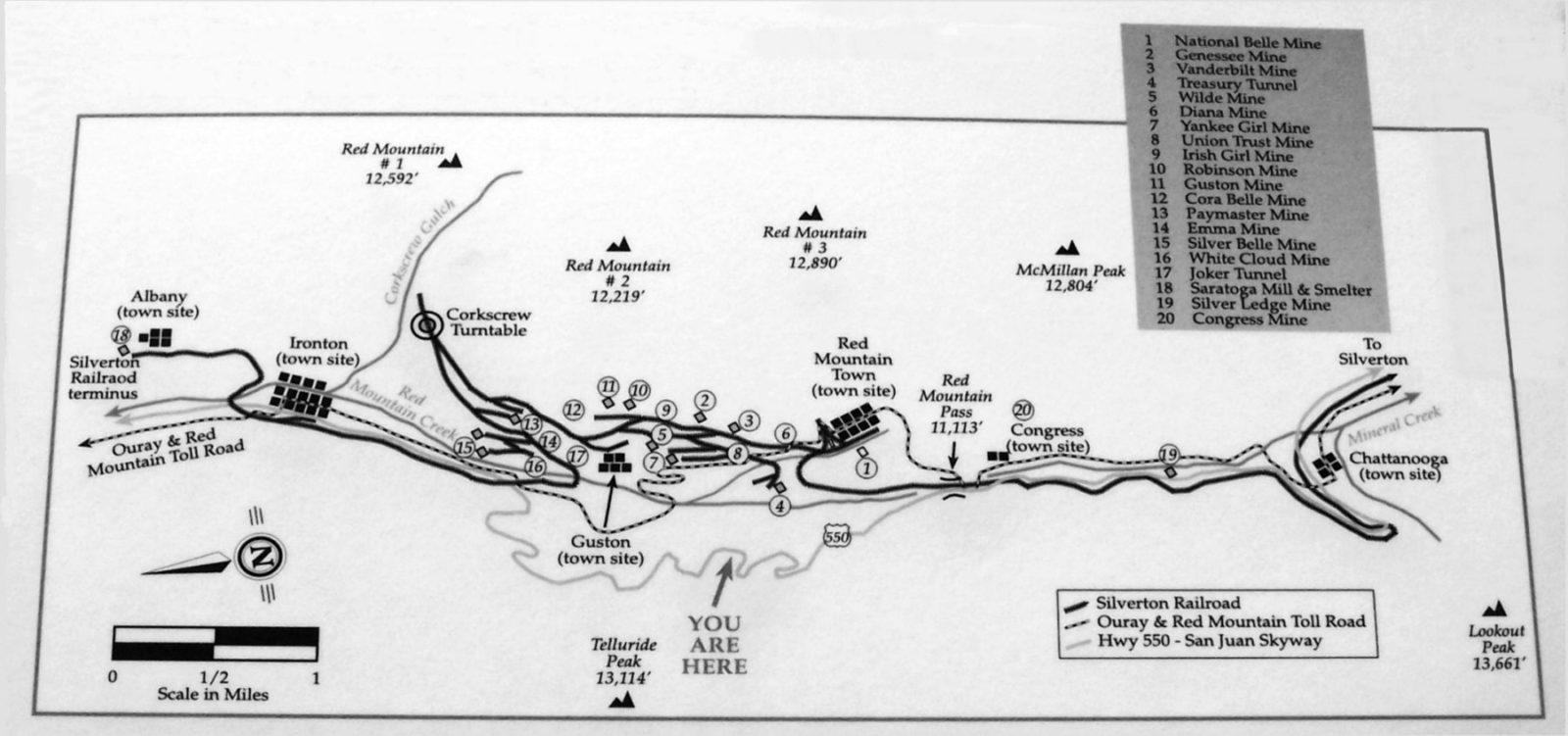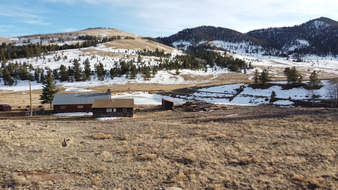
Today I would like to share with you a hidden gem. One that is nestled at the foot of Mount Baldy, in a lush meadow. It is so tucked away that unless you had directions or knew the way you would not know it exists. I am referring to 31 Mile Ranch, which is a privately owned historic site and rental property. As you enter the property you are greeted by a striking Duch-colonial barn set against the backdrop of a sun-soaked valley and a modern cabin with all the high-tech amenities you could need. I had the pleasure of staying on the site and was fortunate to be able to speak to the landowner, who provided us a wealth of information about the property’s history and its potential future.
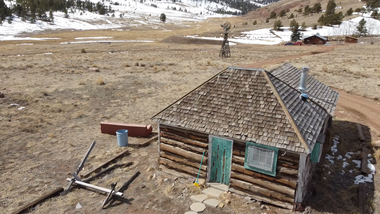
The ranch has a sorted tale complete with debutants, cowboys, and heartbreak. One that is well documented in the local newspaper and by historical records that the property owners have kept and passed down as a family heirloom. I was fortunate to be granted unprecedented access to these documents and look forward to sharing the story of 31 Mile Ranch.
The first mineral rights records on the property date back to a claim that was made in 1883. The original settlers continued to renew their mineral rights until 1942. But no major mining operation was ever developed on the land. Rather a 600-acre plot of land was homesteaded by Charles V. Corliss on June 16th, 1921. 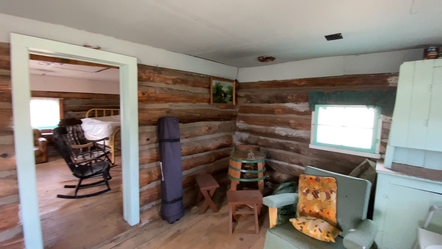
To the best of recollections, the two-bedroom log house that stands today was built in the 1880s by the original mineral rights owners. A large 5-bedroom log house was built in the early 1900s by ranchers who leased the area from the government. The architect who built the windmill and house was an artist and builder from Colorado Springs named Benjamin Lefkowsky. The windmill that we see today is all original except for one replaced blade. It once pumped water into a tank inside the attic of the log house, supplying it with running water. The attic of the home used sawdust as insulation and unfortunately, in 1950 a hot stove pipe caught the sawdust on fire and the house burnt to the ground. Today we can still see remnants of the stove that caused the fire amongst the foundation of the home.
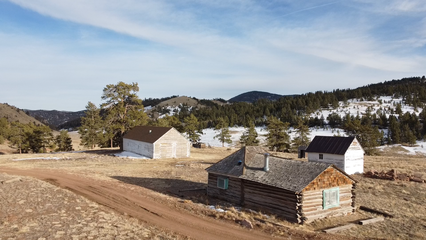
Before the house burnt; in 1925, Barbara Monell-Glaze purchased the ranch from Charles V. Corliss and constructed the 5-bedroom log house. Barbara was known to be a very social lady, who held dance parties once a month on the top floor of her barn. Barbara's father: Ambrose Monell, was very wealthy as he was the president of the International Nickel Co and a director of several important banks. Her father afforded her a lavish lifestyle with a $1,000 a month allowance. Which in today's currency would equate to over $15,000 a month. But Barbara shunned the glitz and glamor of her father's lifestyle in New York City, she was a self-described “Horse Woman”. Hence why she made her home at 31 Mile Ranch.
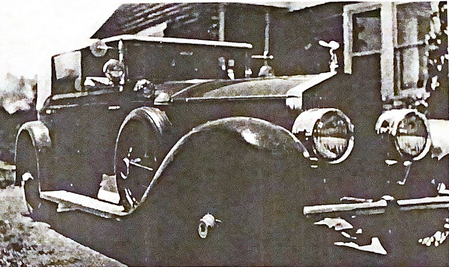 Barbara's Rolls Royce & Home Barbara's Rolls Royce & Home
Her love of horses was a lifelong passion. She had won many ribbons in both the Western and Southern horse circuits. She described it as her favorite pastime; however, others said it was a full-time love affair. Before becoming an accomplished equestrian, when Barbara was only 16 years old, she completed a 2-mile swim in Newport. Astonishing the doubt-filled Newport elite.
Though she was not all grit-and-spit and occasionally used her wealth to indulge her decadent side. For example, when she was not enjoying her horses, she was known to drive around the county in her Rolls Royce convertible. And before moving to the ranch she lived in an exclusive Colorado Springs Resort, the Broadmoor; but more on that later. 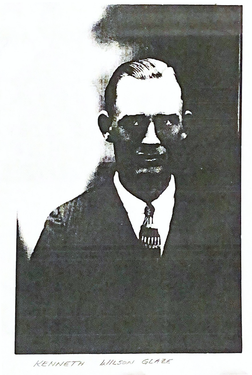 Kenneth Glaze Kenneth Glaze
ile frequenting the local rodeo she in-passing met Kenneth Glaze who was a rancher and rodeo performer. But they were not properly introduced until she needed a bridal (for a horse) repaired, and she found herself in Colorado Springs at Kenneth’s harness shop. During this exchange, she discovered that Kenneth was an expert horseman and romance bloomed rapidly. Interestingly, this was not her first time in his shop. Before moving to Colorado Barbara visited and brought her dogs with her. Not realizing that her dogs were required to be on a leash in the city of Colorado Springs and as a result, she found herself in Kenneth's shop. Their chance encounters were almost serendipitous as if it were a match made in the heavens.
The local paper described Kenneth as “a cowpuncher, wild west performer, and harness shop proprietor.” They went on to say, he was the picture of “physical perfection, six feet, and one-quarter inches… weighing 176 pounds. He is of the type that would fit well in a ranch picture… he is of the great brand of westerners.” Kenneth was only 13 years old when he moved from Illinois to Colorado, with his parents. He rode the ranges of South Park County for 7-years. Until he decided to drive his herd of horses 66 miles away, to Colorado Springs. Where he sold the horses and used the proceeds to purchase his harness shop. Where he remained for another three months before meeting Barbara Monell. 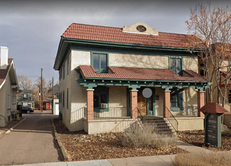 Barbara & Kenneth's Apartment Barbara & Kenneth's Apartment
For a time, the couple resided in a modest first-floor apartment in Colorado Springs. The Colorado Springs Gazette peered its nose down on Barbara by saying she had undergone a “metamorphosis from gilded lobbies and refined drawing rooms to a three-room apartment and preparing her own meals with a grace that only a newlywed can muster”. However, their long-term plan was to wait until spring and move to “a ranch in Southwestern” Colorado. As Kenneth put it, he was “enthusiastic over the prospect of a free and untrammeled life in the open”.
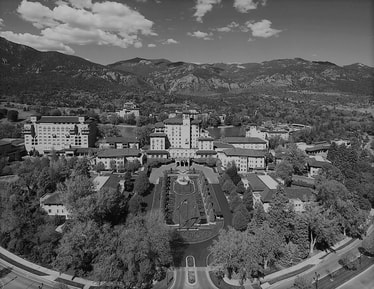 The Broadmoor Resort The Broadmoor Resort
Their relationship was watched closely by residents of the fashionable and high-end community, the Broadmoor. This is because before moving into their simple Nevada St. apartment, Barbara lived in the Broadmoor, where suiters fell upon themselves to catch her eye. She only stayed for four months at this posh location and her quick departure led to all sorts of speculation. However, the stay was always intended to be short-lived, as she was recovering from a surgery that she had undergone that fall. At the recommendation of her mother, she decided to recover in Colorado; however, to her mother’s dismay, she loved the area so much that she decided to stay permanently.
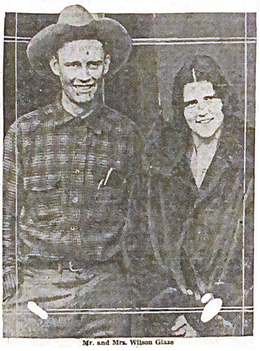
On February 21, 1928, the couple was married 5-weeks after she purchased the bridal and 3-years after Barbra having arrived in Colorado. He was 27 and she was 23 and they were said to be madly in love and to have a romance that “bloomed rapidly”. The Colorado Springs Gazette and Telegraph reported that their relationship was “love at first sight between one of New York's best-known debutants and heiress to millions and a bronzed giant cowboy of Colorado Springs”. They went on to say it “culminated in a wedding that gave Gotham something to gasp over”. The ceremony was shrouded in secrecy and only close family members attended the small gathering in the Monell home. Barbara intentionally registered for their marriage license using her Colorado Springs address rather than her New York City address, to avoid raising media attention ahead of the ceremony. It took the local paper a full 10-days before they realize and reported on the uncommon marriage.
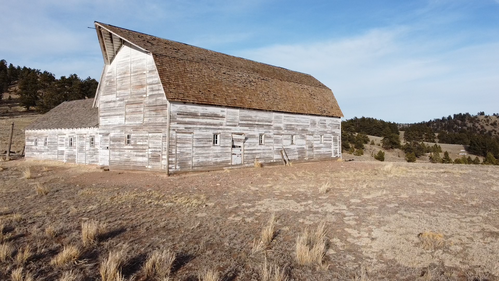
Barbara's father had little to say regarding his daughter's choice of husband. But he did deliver an ultimatum to her on her wedding day. Reportedly saying “if she were to marry again, he would disown her”.
Shortly after their marriage, a local man named Franklin Nash recalled Barbara negotiating with his father (W. Nash) to purchase six head of registered Herford cows. According to Franklin, Barbara did not want her husband (Kenneth Wilson Glaze), to know she was purchasing the cows. That same year: in 1929, they had the Gambrel roof barn built, which stands nearly 100 years after its construction. I speculate that the purchase of the cows was an attempt to make the construction of the barn a necessity. Regardless, Barbara's ranch was very elaborate for the inter-war period in this area of Colorado, because most ranchers of the era could not afford an investment of this scale. 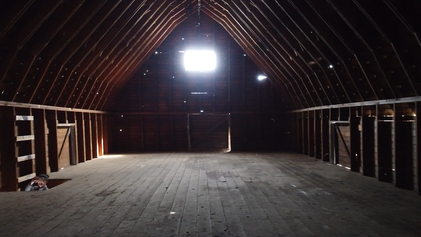
In a 1999 interview a local woman; Ruby Ankrum-Werley, spoke about some of her times on the ranch when she was 20 years old. Rudy had resided in Fremont County since 1931 and recalled when Barbara Glaze moved to the house on what was at the time called the “Skyline Ranch” or "Green Mountain Ranch". Ruby attended Barbara’s housewarming party in 1934. During the party, one guest spilled a glass of wine on another guest. Without hesitation, Barbara took them to her closet and told the wine-soaked guest to choose any dress they like. It was a gift to the guest; however, Barbara had little need for the multitude of fancy dresses that she owned. This is because she never wore them. Ruby stated that Barbara preferred to wear trousers and men’s style lace shoes. She elaborated by saying, “in the 1930’s women always wore long dresses, so Barbara Glaze was quite a gossip among the local women”.
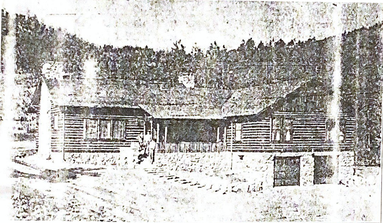 The Monell-Glaze Home The Monell-Glaze Home
Nearby newspapers reported on the housewarming party and the home, saying, “the beautiful mountain home of Mrs. Barbara Monell-Glaze… The home built of logs was recently completed and opened at the housewarming to which many Canon City people were invited. The home contains 11 rooms and three baths. A two-car garage in the basement houses her Rolls-Royce and Auburn cars”. In other words, this house sported a size and amenities that were not common in most American homes at that time. 18-20 years after its construction, in the 1950s, it was common to see homes of this size, with attached garages. I suppose Barbara had Architectural tastes that were ahead of her time. The home she built was in sharp contrast to the other homes in Guffey Colorado. It was described as “the finest of its kind in the state”. She made a splash with the locals by bringing her own breed of Park Avenue flair to Southern Colorado.
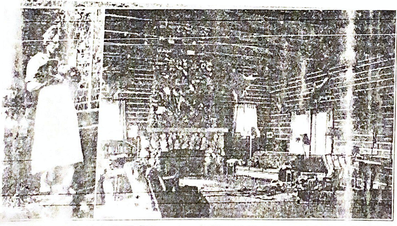 Barbara In Her Living Room Barbara In Her Living Room
The article went on to describe an immense living room with two fireplaces, plush leather seats, and built-in bookshelves. The walls were lined with fine beads and animal skins. But this was not what Barbara choose to showcase during the interview, she led the reporters to the front entrance. Where just outside sat her dog kennels and an opportunity to share with the community another one of her hobbies, raising huskies/sled dogs.
This housewarming party was just the first of a regular series of ‘open houses’, or what we would call today, house parties. Residents from the area were said to dance the night away and eat what was called a “midnight lunch”. Or in other words, they partied all night and had a late-night meal. Barbara’s party dress was described as “Canon City Trousers, a shirt open at the neck, Indian moccasins, and a jaunty tam (or beret)”. Her close friends would joke that she was just a “regular guy”. 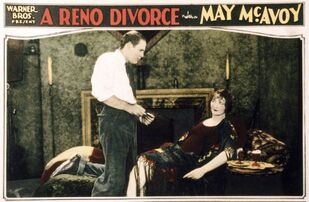
Unfortunately, the romance and good times did not last, and they were divorced in 1931. The headlines read, “Marriage of Heiress and Harness Maker May End in Divorce Court”. However, to get divorced at that time was not that easy, especially for a woman. This is because the accuser was required to prove they had grounds for divorce. Which in most cases came down to a case of he-said-she-said. There was no guarantee that the courts would grant a divorce. It’s no wonder so many people who faced a lengthy, arduous, and uncertain divorce opted to go to Reno Nevada. Where they advertised themselves as the “divorce capital of the world”. This is because they had an expedited divorce system, that after only 6-weeks of residency, they could rubber-stamp a divorce in minutes. Fortunately for Barbara, had the means and wherewithal to establish residency in Reno. In March of 1931, she announced that she intended to establish residency in Reno for the purpose of initiating a divorce.
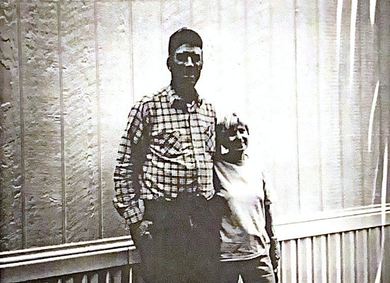 Kenneth W. Glaze & Kenneth R. Glaze Kenneth W. Glaze & Kenneth R. Glaze
The firstborn son of Kenneth, Kenneth Richard Glaze; recalled in a 1999 interview that Barbara gave the ranch to his father after the divorce in 1932. But according to his recollection, his father lost the land one year later to what he called “fraud paperwork by Colorado Springs lawyers”. His last recollection of Barbra was that “she was living off on Highway 115” with a new lover, “Bob Ford”. He went on to say that “they may or may not have been married”. Which I can imagine only added fuel to the townsfolks' gossip and the Manhattan-based scandal.
However, it seems the fraudulent paperwork that Kenneth R. Glaze recalled was legitimate. This is because shortly after the divorce Barbara Glaze sold the ranch to Jim Luthi on October 22nd, 1932. Meaning; Kenneth W. Glaze would have been evicted from the land. 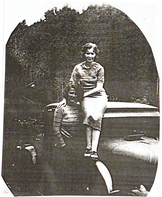 Barbara Monell-Glaze & Cleota Dunbar-Bell Barbara Monell-Glaze & Cleota Dunbar-Bell
During the same year, an unlikely friendship was started between Barbara, and a young lady named Cleota Dunbar-Bell. The friendship blossomed rapidly and added to the townsfolks’ speculation that Barbara was a homosexual. To add to the evolving town scandal Cleota was only 18 years old and Barbara was 32 years old, literally twice Cleota’s age. Regardless of the locals’ suspicions that was a large age gap for a friendship or relationship, especially at that time. Cleota had attended Barbara’s barn dances multiple times and had been acquainted with Barbara for some time. Even though Cleota had spent several nights visiting with people in the “big log house” she did not find herself in the same social circles as Barbara.
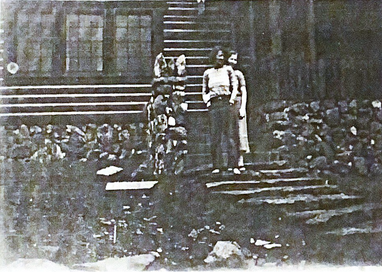 Barbara & Cleota 1932 Barbara & Cleota 1932
They were not formally introduced until Barbara moved to Canon City and began shopping at the Canon City drugstore, where Cleota worked as a clerk. Barbara had become a regular at the store after having purchased a home on the corner of 7th and Main (in Canon City). Cleota recalled Barbara pulling up to the drugstore in her Rolls Royce, being freshly divorced, and being the “talk of the town”. On December 28th, 1932 Cleota was married to a man named George Bell and her friendship with Barbara faded as the time came to pass. Little was heard of Barbara Glaze in Guffey or Canon City after this. She did resurface, for a time, in Denver Colorado. She was remarried and Barbara’s father kept his word and disowned her. Unfortunately, she was last seen in 1935 driving a beer truck in Denver.
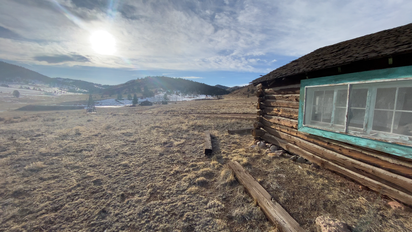
31 Mile Ranch found its way into the hands of a man named John Robinson, who owned the ranch for much of the 1940s. He held parties for school children in the barn. In a 1998 interview one of the students, Rose May White; talked about her times on the ranch, as a 6-year-old who attended his parties. She mentioned a time when a friend of hers fell from a horse and broke her pelvis. Shortly after this incident, the ranch was sold for a time to a gentleman named Louis Greer. It was during his tenure on the land, where we lost the home built by Barbara Monell-Glaze.
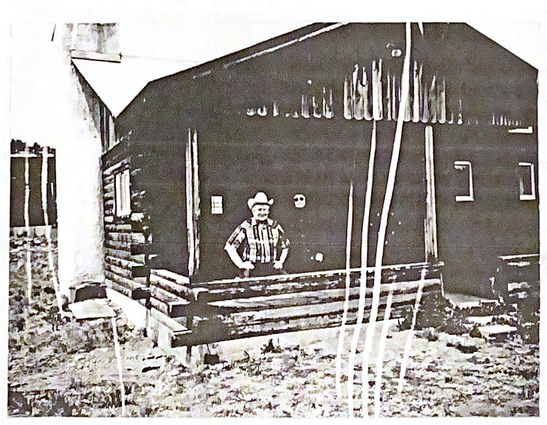 Wilbur & Larraine Sigler In Front of Their New Home Wilbur & Larraine Sigler In Front of Their New Home
Later in 1950; the ranch was acquired by Wilbur and Larraine Sigler. They Purchased 3,000 acres for $10 per acre. This purchase equates to $335,097 in today’s currency, which even with that lens on is a particularly good deal. The 5-room log building that was built by the original settlers served as a temporary bunkhouse for the Sigler’s. It remained this way for a decade, until 1960; when Wilbur Sigler had the existing and modern house built by a man name, Mr. Lafferty. The house features a stately, yet rugged fireplace that was handcrafted with local field stones, by a gentleman named Wilbur Earhart. The home is built with a traditional tongue and groove log cabin style and the timber came from the nearby town of Howard Colorado. The home was powered by a modest 110-volt Onan Generator that sat in a shed behind it. It was supplied water by a spring that sat just a quarter-mile up Paris creek. Three years later Wilbur commissioned local men; Bob and Don Ankrum to construct a pond outside the front door of the cabin. Setting the tone for a picturesque mountain retreat that remains in place to this day. Wilbor and Lorane lived in the house during the summer months, where they raised cattle. During the winter, the home and ranch were left to the elements as the Sigler’s returned to their Permanent home in Boone Colorado. The couple sold the land in 1977 and continued to lease the ranch until 1989.
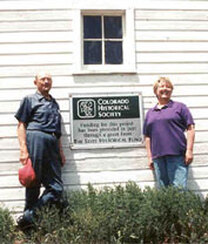 Mr. R.W. "Curley" Reynolds with Kathie Moore, of the Park County Historical Society Mr. R.W. "Curley" Reynolds with Kathie Moore, of the Park County Historical Society
Eventually, 31 Mile Ranch and its surrounding lands were acquired by the Bureau of Land Management. This is where it remained for 7-years until late 1999 when Mr. R.W. "Curley" Reynolds acquired the property through a land swap with the Bureau of Land Management. Upon receiving a grant from the State Historical Fund in 2000 and providing a 50% cash match, he undertook a majority of the repair and restoration work on the barn, the windmill, and log cabin. The exterior cladding of the barn was repaired, new wood shingles were installed on the barn and cabin. Additionally, the ground around the barn and cabin was regraded for better drainage. The windmill was repaired by replacing a single blade. Additional labor was provided by the Park County Historical Society, which gave considerable effort to this project.
Today the home, bunkhouse, and surrounding property is a rental location. Popular with hikers, photographers, wildlife enthusiasts, and people who are looking to escape the busyness of their day-to-day. The beautiful landscape combined with the old-world-ranch charm makes 31 Mile Ranch one of the most authentic Colorado experiences you can have. If you are looking to step back in time and get away from it all, I highly recommend booking a trip to 31 Mile Ranch. You can find information on how to book your mountain get-a-way using the links below: Photos From The Day:Potential EVP Recorded At 31 Mile Ranch (members only): Click HereMusic From The Video:
0 Comments
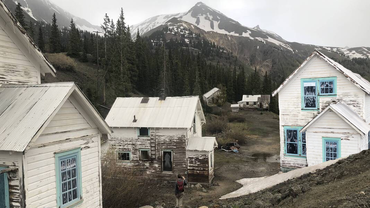
Idarado & Red Mountain Town are a bit of an enigma and is a hard townsite to identify. The final resting place of Red Mountain Town is equal distance between Oury and Silverton Colorado off of U.S. Highway 550. However; the town was moved once and burnt twice. Meaning you can find a few versions of Red Mountain Town. The Denver Times described the town by saying “Red Mountain was the mecca for all who were allured into the San Juan by the fickle goddess of fortune.”
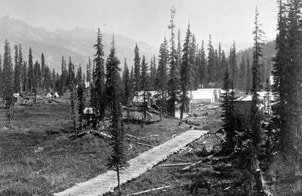
The original town was settled in 1879 when a group of silver deposits were found nearby. At that time it was a small mining camp and went by the name of Sky City. The camp was below the National Belle Mine; however, it would later be relocated. This is because the residents of Sky City first built their camp in wintertime when the ground was frozen solid. Once spring came around the townsite became swampy, fly-infested, and messy.
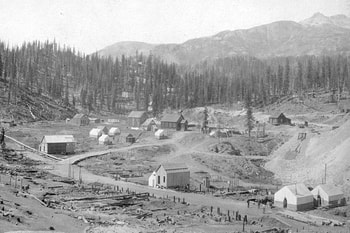
At the same time, several other settlements and tent cities were also being established in the Red Mountain Pass, including Barilla and Rogersville. Which were also situated below the National Belle Mine.
A surveyor from Silverton Colorado made his way to Rogersville and plotted out the first town plat. It was comprised of four streets and one business. Around this time the people from Sky City decided it was time to get out of the swamp. They packed up and relocated directly next to the Rogersville townsite. This was only a move of a few hundred yards, but it made all the difference for the miners of Red Mountain Town. They were closer to Otto Mears’ toll road (the million-dollar highway) and the National Belle Mine. Not to mention away from the increasingly swampy conditions of the then defunct Sky City. 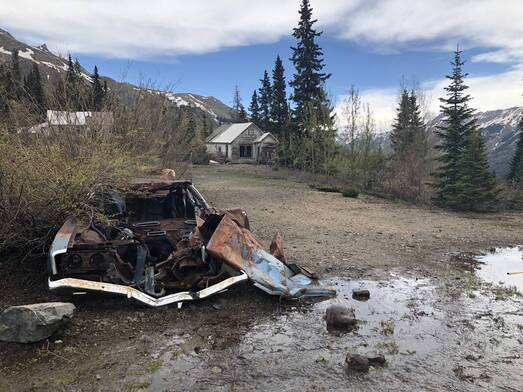
They had established a town company and petitioned for a post office. The post office was established in January 1883; despite the fact that it was primarily made of tents and had few permanent wooden structures. When the post office was established, it was the first settlement to dawn the name “Red Mountain Town”. In short order, the town had two newspapers, numerous homes, a hotel (The Hudson House), and a multiple story Saloon called the “Assembly Club”. By this time the town of Red Mountain had incorporated the surrounding communities of, Sky City, Sweetville, and Rogersville.
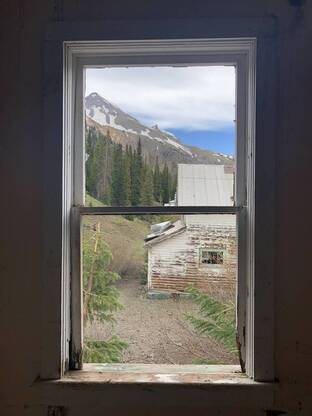
Meanwhile back in Barilla; a competitive townsite had quietly been building up a little further north and today rests on the north side of the Million Dollar Highway (U.S. Highway 550). This town was less than a mile away and decided to take the name “Red Mountain City”. This was controversial and was intentionally designed to irritate the residents of “Red Mountain Town”. Keep in mind that all of the communities in the Red Mountain Mining District were competitive, but the proximity and similar names made the rivalry even more bitter between these two camps.
Almost immediately there was confusion between the two settlements. Shipments of supplies would be incorrectly delivered and seldom were returned. Several disputes were recorded concerning misunderstood deeds and bank transactions. To exacerbate the confusion, both newspapers referred to their town as “Red Mountain”. Acting as though “Town” or “City” were never a part of either town's name. The editors of each newspaper would exchange weekly barbs through open letters, editorials, and occasionally direct accusations. 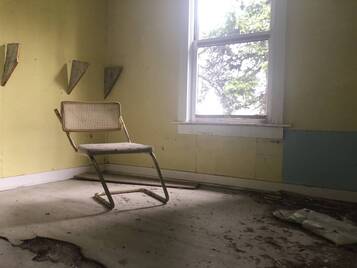
The entire Red Mountain Mining district was talking about this rivalry. The naming dispute was finally put to an end when Red Mountain City petitioned for a post office. The U.S. Postal Service chooses to call the town “Congress”. Because the town was closest to the “Congress Mine”. The newly coined town of Congress was the loser in more ways than one. This is due to the fact that most of the silver deposits were on the south side of the Million Dollar Highway. By 1887; just 8 years after the feud began, only a few residents remained in Congress and Red Mountain City was a thing of the past.
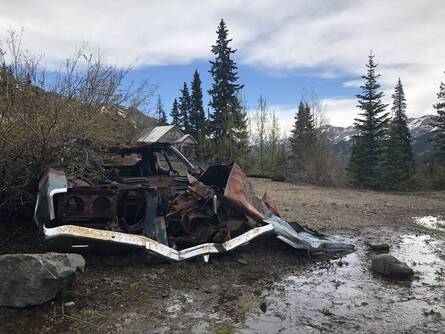
It seemed as though the miners of Red Mountain Town and the National Belle Mine had a limitless supply of luck. Especially, when in 1887 they found a massive cavern filled with gold and silver. The lucrative find was reported across the United States. Overnight international investors began to pour money into the town and mine. By 1888 the Silverton Railroad was connected to Red Mountain Town. They were happily boasting as having “an escape-proof jail”. Basically; they had come a long way from their humble ad swampy beginnings. 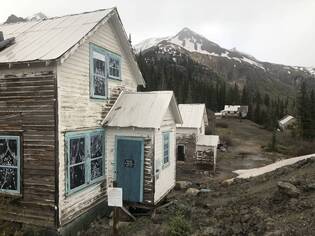
Despite all of the civic improvements it only had a population of 598, by 1890. The town had a reputation as one of the roughest towns in the Red Mountain District. However; at its peak it hit 1,000 citizens and had numerous saloons and a theater.
In the summer of 1892 a fire began in the kitchen of the Red Mountain Hotel. It quickly spread through the wood structures, in spite of the brave efforts of the volunteer firemen and residents. The fire destroyed the majority of the town. By the time it stopped burning all 15 buildings along Main Street were gone. In-fact only the depot and the jail survived. The gritty group of residents that remained soon rebuilt the town. The town suffered its second fire in 1899, at that time, only 12 citizens remained in the town. 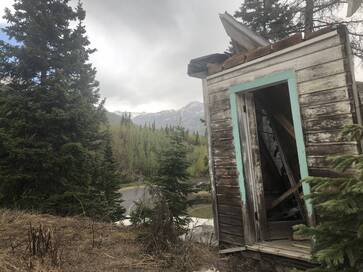
Red Mountain Town saw a brief resurgence in 1901. Along with most of the towns in the Red Mountain District. Many people predicted that the town and the mines would thrive again but they never did. At this time, several of the area mines were consolidated into the Idarado Mining Company (later to be acquired by The Newmont Gold Company). The National Belle, Guson, Terusry, Congress, and dozens of other mines were all consolidated. The new mining operation eventually created 100s of miles of tunnels. So extensive that they still connect below the city of Telluride and the remains of Red Mountain Town.
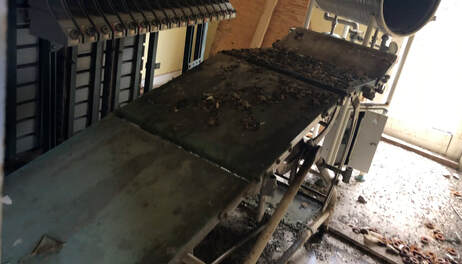
The town limped by until the Idarado mines and mill closed in 1978. At this point, Red Mountain Town was primarily used for seasonal and short-term housing for the miners. In 1983 the State of Colorado filed suit against the Idarado Mining Co. for natural resource damages and the subsequent lead poisoning. A few people remained in Red Mountain Town until 1986, when a study (financed by the Idarado Mining Co.) found 7% of the children tested in the area had above average lead levels, in 1993 the Centers for Disease Control concluded that the lead levels were 3% higher than previously thought and reported.
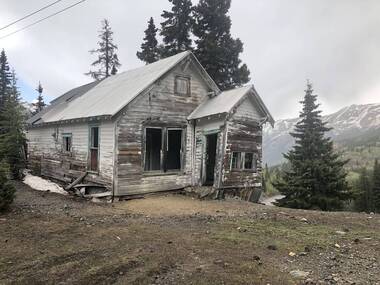
Today, the Newmont Mining Company (formerly the Newmont Gold Company) and the State of Colorado are working to remove lead, acids, zinc, and heavy metals from the region and its water supply. They are pioneering new methods of revegetation that will one day; hopefully, cover the tailing piles that litter the valley.
The remains of Red Mountain Town can be seen from the top of Red Mountain Pass, 13 miles South of Ouray. For a closer look, the Red Mountain District can be accessed with an ATV or high clearance vehicle on County Road 31; 12.8 miles south of Ouray. Map of the Area:Learn More About Idarado and Red Mountain Town:
“Their architecture and construction are not significant for their artistic value or skilled craftsmanship,” the report states. But, it goes on to argue: “Together, these houses form a fine example of company housing in an isolated mining setting — a story important to the history of the region.” ~Samantha Tisdel Wright
Read More of her article in this link 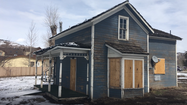
While returning from a visit to Glenwood Springs we stopped for gas in the sweet little Mountain town of Gypsum Colorado. Gypsum is a relatively new city, which celebrated its centennial in 1982. Unlike most of the towns in the region, it is not a mining town. In fact, its primary industry is agriculture, specifically potatoes.
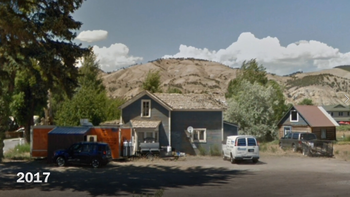
I found this unique little two-story abandoned home captivating. You don’t normally see an abandoned home off a major intersection, next to a brand new service station. It turns out this property was occupied as soon as 2017. In fact, the last owner operated a taco truck off the land, it was appropriately “The Orange Taco Truck”. From what I understand it had amazing salsa, but the food trucks life was short lived.
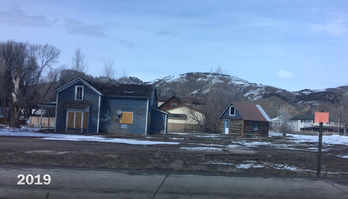
The house dates back to the 1930’s; however; the adjacent cabin appears older. The cabin has been well kept and shows signs of recent restoration. While the home shows signs of neglect; buckling roof, ancient shingles, and likely filled with asbestos or led paint.
My best guess is this property was sold for redevelopment or was condemned by the city. Judging by the byt the age of the property and the size of the lot, I feel this house has more of a story to tell. Unfortunately, little records exist; however, I was glad to have captured the house before it is leveled and repurposed. If you know anything additional about the property and its history please comment below. 
As we explored a local Canyon, an old homestead caught our eye and we decided to take a closer look. Needless to say, I was thrilled to find an expansive property, with many signs of American settlers and historic wagon trails. I was surprised at how much historical information was available about the property and how well preserved it was.
In 1894, Patrick and Margaret Lucas paid $10 for this 160-acre homestead. For nearly 50 years they lived and worked here, raising a family of eight children and building many structures that continue to give us clues and inspire stories about life on a historic western homestead. 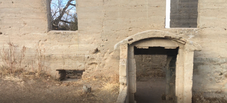
The Lucas home is built of concrete, an unusual choice for the time when most homes were made of wood. However; it allows us to have a glimpse into the life of an 1800's homesteaders. Since Margaret left the property in 1941, the house was empty but intact. Unfortunately, a fire destroyed much of the house years ago, but what remains gives us an idea of its original size and hints about the interior and exterior. For example, the opening in the back wall gives historians insights into what the family ate, what they used to heat the house, and what types of local medicines were made.

The Apple Tree planted by Patrick and his children can still be seen on the north side of the property. They still bear fruit in autumn and have been here for over 100 years. Each spring, On the eastern side of the property, you can see Margaret's lilacs bloom. Perfuming the air around rock outcroppings that her children once played on.
The 160-acre estate fell into abandonment for more than 100 years. Eventually, the descendants of the Lucas family donated the land to an organization called "Friends of Castlewood Canyon". Later the property was sold to the state of Colorado and was added to the adjacent state park, "Castlewood Canyon State Park". 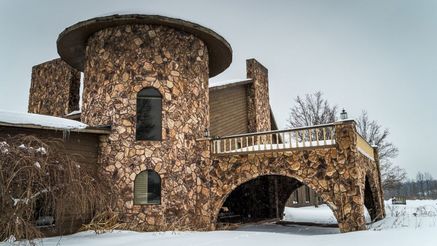
In the early 1980s, Mike Tyson owned a monstrous mansion in, Ohio. The world heavyweight champion boxer built this 13,500-square-foot mansion in order to be near the facility of his promoter, Don King.
By 1988, he was at the top of the boxing world and throughout those years he lived in this garish mansion. Purchasing cars, expensive clothing, and many other things, including a $2 million bathtub (featured below). The Ohio estate included lavishly decorated rooms with imported crystal chandeliers; it had five-bedrooms, tigers in cages, a full kitchen, and a mini-kitchen. His pool was larger than most houses. On the floors stretched zebra print carpets. The structure was garish, the rooms were huge, and the light flooding through the windows was a relief from the fluorescent track lighting. The later abandoned mansion was Tyson’s home until March 26, 1992, when he was convicted and sentenced to six years in prison for the rap and sexual assault of a member of the “Miss Black America Pageant”. Tyson was 25 at the time of the crime. He was sent to the Plainfield Correctional Facility. 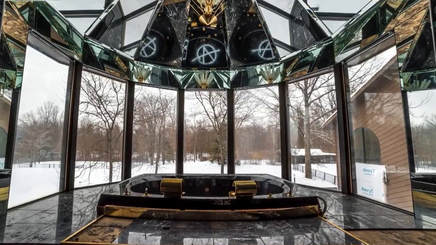 A $2 Million Bathtub A $2 Million Bathtub
Tyson was released three years later, but he was convicted again, this time for a traffic accident in 1998. Directly after the accident, he assaulted two motorists. He was sentenced to another year in prison. When he got out, he continued to struggle financially and was forced to put the Ohio mansion on the market.
In 2003, Tyson filed for bankruptcy. On the TV talk show The View, Tyson said he was “destitute and broke”. Tyson’s mansion sat abandoned throughout this time. In 2010 Tyson’s mansion had a chance to be occupied. When it was purchased by the entrepreneur and businessman Paul Monea. For a steal at $1.3 million, but Monea never lived in the house. Monea was under investigation for money laundering. The FBI set up a sting by acting as a connection to a drug lord. Monea was arrested and eventually convicted of conspiracy and money laundering. He remained in prison until this year (2018). Mike Tyson’s mansion sat abandoned partially due to its location and partly due to its size. Not many people wanted to spend this much to live in the Ohio countryside. The mansion remained empty until 2015 when a local church acquired the property through donation. Thankfully it has found a new use and did not go to waste. 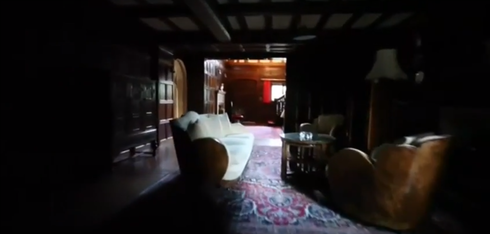 David Gilmour's Home David Gilmour's Home
If you've seen the videos of the abandoned millionaire mansion once owned by David Gilmour of Pink Floyd, take a look at how magnificent the mansion was before it fell into a state of disrepair. This video also shows some footage of the recording studio.
Click here to see what the mansion looked like before it was abandoned. Thanks to YouTube creator GM for the property information below: The manor house was originally built for the Bishop of Reading in 1580. Other parts have been built on at various times since. The house sits on 25 acres of grounds in south Oxfordshire, 6 miles from Reading. The house has seen many owners, some notable owners have been: Sir Charles Clore who was one of Britain’s most successful post-war businessmen who owned a pharmaceutical company and later Selfridges. 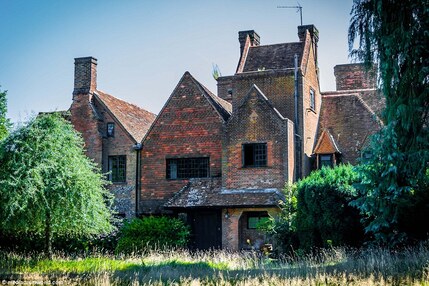
Alvin Lee, vocalist and lead guitarist of the blues-rock band Ten Years After, bought the house in 1972 and built a recording studio in what was then a dairy and originally a barn at the side of the house which he named Space Productions. Lee also built a squash court which caused some structural problems and the building had to be knocked down. The recording studio is now housed in a purpose built building through the timber and some other materials used, came from the old dairy.
David Gilmour of Pink Floyd bought the house in 1980, Gilmour also used it to record some of Pink Floyd’s music in the studio. In 1987 David Gilmour sold the house to Clive Langer and Alan Winstanley of West Side Productions, producers of Madness and Morrissey. Music producer, songwriter, musician and singer, Trevor Horn bought the house in the 1990s, Horn named the recording studio Sarm West Studios. 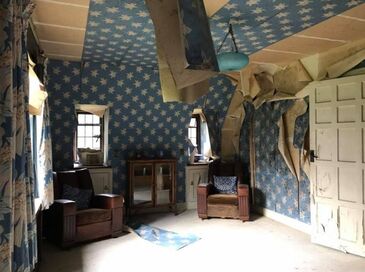
Mark White then bought the house in 2007. Mark White set up a production company and continued to use the recording studio commercially, the production company was dissolved in 2014 though it is believed that the studio has since remained in use. It’s not clear how long the manor house was unoccupied for but between 2007 and 2017 the house seemed to be neglected and fell into disrepair.
Several major rock bands have recorded albums at the studios. These include Manic Street Preachers' Gold Against the Soul, The Cure's Disintegration and Mixed Up, and Marillion’s Seasons End and Holidays in Eden. Rod Stewart, Tom Jones, Kaiser Chiefs, Jamiroquai, and Spandau Ballet also recorded at the studio. David Gilmour used one of the large outbuildings at the back of the house to store the inflatable Pink Floyd pig. The main blue bathroom suite dates from around 1900 and was manufactured by Royal Doulton who asked Trevor Horn if they could buy it back to put it in their museum. It would seem that Horn declined to sell it back to Royal Doulton! 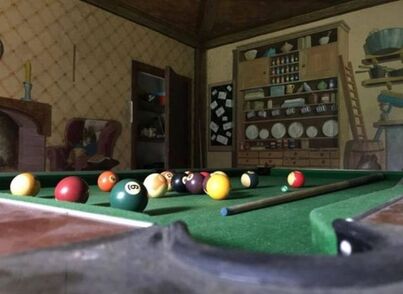
Alvin Lee supposedly moved out due to the manor house is centuries old, he found it impossible to heat properly in the winter and something always needed repairing. He also reportedly said he found it ridiculous living in such a large house.
The Manor House is reported to be haunted and David Gilmour moved out when allegedly his wife could not stand the ghosts anymore! Trevor Horn moved out after his wife was accidentally shot in the grounds of the manor. She suffered irreversible brain damage when son Aaron was practicing with his air rifle, not realizing his mother was close by. It is believed that Mark White still owns the manor house which is now undergoing renovation work. |
AuthorThank you for visiting! This is a collection of media from the lost and abandoned corners of the world. Please have a look around, I hope you enjoy. Archives
April 2022
Categories
All
|
Libraries |
Support |
|

